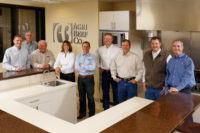Destiny DRIVEN
Cynthia Castaneda’s individual bird-deboning record stands at 25 seconds, a feat she reached in four years on the job. Bill Andersen introduces a company-wide problem-solving, solution-driven initiative called Endeavor for Excellence (Endeavor) based on continuous improvement. Veronica Burgess presides over the fully-cooked chicken process. Her superiors say what she does not know about batter, breading, and cooking is not worth considering. Eric Smith worked his way up from production to a supervisory position, proving the theory that says the cream rises to the top. Marc Glassco knows how to crunch data to drive production excellence, and he delivers numbers that prove it.
As further-processing plant manager, Victor Jiminez is a masterful juggler providing leadership for a 250,000-square-foot production site responsible for processing 200-million pounds of chicken products a year. The common denominator concerning these six poultry-industry professionals is their collective commitment and dedication to growing the chicken business of Gold Kist Inc. They are assigned to duties at the company’s Boaz, AL, further-processing plant operating with a total workforce of 1,000, responsible for two production shifts and one for sanitation purposes. They know that work is the price of success.
“The culture of our company is about empowering people,” Jiminez says. “We believe in our people. Our mindset is that you control your destiny by building in quality and productivity. You can’t inspect it in.”
Components of the Endeavor program include product specifications (process and product parameters), equipment control (production line monitoring system), and statistical process control (analyzing product quality performance and process capabilities through fact-based management).
“From the time we receive it until it reaches its final destination, all product is measured and tested constantly against the customer’s specifications at monitoring stations throughout the plant,” explains Andersen, who will succeed Jerry Stewart as the company’s vice president of sales and marketing in April.
“By making decisions with precision using the Endeavor program, we consistently out-perform management systems relying on periodic inspections.”
Andersen, who likens Endeavor to the industry’s farm-to-plate initiative — designed as a sequential chain of production and processing links — emphasizes the critical role of human capital.
“Employees are more involved in the process,” he says. “It used to be they were expected to get on the floor and run chickens. Now, they are empowered to take ownership of the whole production process. That is important, because our customer specifications and parameters have gotten so tight, we can’t afford to be off even a little bit.”
Technology is the other part as Glassco explains. “There are several thousand parameters involved with equipment or products,” he says. “We don’t make false promises because technology enables us to use facts to make decisions. This gives us credibility with our customers.” For example, between 9 a.m. and 3:20 p.m. on a day in early December, computer records indicated 1,700 individual checks on a single packing line. Strategic implementation of the Endeavor program includes prototyping processes, using best practices to reduce cost and assuring the highest quality.
Glassco, as yield coordinator and Endeavor champion, closely monitors the amount of meat harvested from carcasses on the deboning line to determine maximum yield capability. Consider Cynthia Castaneda. Her performance on the deboning line brings new meaning to yield as it relates to rate of production. You would think she owned the arms and biceps of an Olympic game competitor. She does not. Not much taller than 5 feet, her slight frame is noticeably devoid of body fat. She wields her knife fast, and no sooner than a bird is positioned it quickly becomes very close to a clean carcass. Although she holds the record, her fellow line employees are also adept at deboning chickens. The average production rate is 384 birds a minute in an eight-hour day. Although the plant does not operate on a quota system, an incentive program provides an opportunity for increased earnings to those who exceed the average production rate. Specifically, workers earn extra pay for each bird over the average rate. Although fast is good, the ideal is to remove as much meat as possible, which is why Glassco can be found conducting meat availability tests on 30 birds a day. The process involves scraping the carcass to determine if any product remains. By Glassco’s count, the line is missing only a “very small percentage” of available product.
“This helps us focus on improving the system,” Glassco says. This attention to continuous improvement led to the current stationary breast-removal system. Two years ago, the plant operated under a flow system in which 136 deboners worked on a moving cone line. Each person made a single cut toward the ultimate disassembly goal of primarily harvesting breast meat, wings, and legs. The new system cleared the way for several efficiencies including increased productivity and yields, explains Smith, who joined Gold Kist in 1988 and worked his way up to a unit management position over the deboning section.
“What this meant for people like Cynthia is the removal of obstacles impeding job success,” Smith says. “Moving lines meant reaching for birds, for one thing. Now product quality and workmanship have improved. There are fewer missed cuts and bones. The stationary line is designed for safety and is simply more ergonomically friendly.” Moreover, turnover reduced significantly, Smith adds. NP

Report Abusive Comment